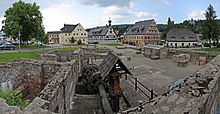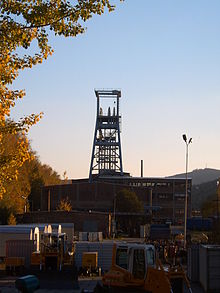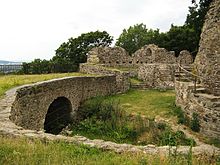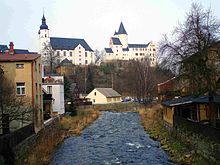Ore Mountains mining region
| Ore Mountains / Krušnohoří mining region | |
|---|---|
|
UNESCO world heritage |
|
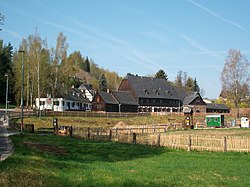
|
|
| Siebenschlehener Pochwerk, Schneeberg |
|
| National territory: |
|
| Type: | Culture |
| Criteria : | (ii) (iii) (iv) |
| Surface: | 6,766,057 ha |
| Buffer zone: | 13,017,791 ha |
| Reference No .: | 1478 |
| UNESCO region : | Europe and North America |
| History of enrollment | |
| Enrollment: | 2019 ( session 43 ) |
The mining region of the Erzgebirge / Krušnohoří is a mining landscape in the Ore Mountains that has emerged since the 11th century , on both sides of the Saxon / Bohemian border. It is characterized by a large number of historically largely original technical monuments as well as numerous individual monuments and factual groups associated with the mining industry. It has been a UNESCO World Heritage Site since 2019 .
history
Since the first find of silver ore in 1168 in Christiansdorf on the urban area of today's Freiberg , which is assigned to the Freiberg mining district , mining was carried out in the Erzgebirge without interruption until 1990. Over the centuries, the mined raw materials included a. Silver , tin , zinc , cobalt , nickel , copper and lead , but also bituminous coal and uranium , were mined until the 20th century and were the engines of Saxony's economic development . Today, deposits of indium , tungsten , tin and lithium are being examined to determine whether they can be mined.
Project progress
- 1999 (September) "mining and cultural landscape Erzgebirge" is on the tentative list for inclusion in the list of UNESCO World Heritage set
- 2001 feasibility study for the project
- 2007 implementation study
- Until 2012, investigation of the objects through implementation studies
- 2008 pilot study Schneeberg
- 2009 pilot study Marienberg
- 2010 Olbernhau pilot study
- 2011 (May) implementation study Annaberg-Buchholz
- 2011 (July) implementation study Ehrenfriedersdorf
- 2011 (October) Implementation study Oelsnitz / Erzgeb.
- Numerous implementation studies in 2012
- 2012 (September) The original proposal on the tentative list is replaced by a transnational proposal that also contains components on Czech territory.
- 2014 (February) Application and official acceptance of the documents by the World Heritage Committee
- 2015 (February) Start of the evaluation of the submitted documents by experts from the International Council for the Preservation of Monuments (ICOMOS)
- 2015 (May) Foundation of the " World Heritage Mining Region Erzgebirge e. V. “as a prerequisite for the sponsorship, mediation and further development of the future world heritage; Members of the association are the districts of the Erzgebirgskreis, Central Saxony and Saxon Switzerland-Eastern Ore Mountains as well as 33 cities and communities
- 2016 (April) Following the official recommendation of the International Council for the Preservation of Monuments (ICOMOS) not to present the World Heritage application from February 2014 to the UNESCO World Heritage Committee and to sharpen the concept, withdraw the application for revision and resubmit it as soon as possible
- 2017 (December) Signing of the revised application by the interior ministers from Saxony and the Czech Republic
- 2018 (February) renewed submission of the nomination to the World Heritage Center
- On July 6, 2019, the UNESCO World Heritage Committee will designate the Ore Mountains / Krušnohoří mining region as a World Heritage Site .
The project was scientifically prepared by the Ore Mountains Mining Region project group of the TU Bergakademie Freiberg under the leadership of Helmuth Albrecht . An implementation study was drawn up in joint working groups with each participating city or municipality. The properties proposed in the implementation study were checked and agreed with the respective municipality. The study contains a description of the nominated property as well as the previous protective measures ( monument protection , nature conservation , listing of the land-use planning ). In addition, all plans on and in the immediate vicinity of the nominated property are determined as part of the investigation. This fulfills the demand of the state government of the Free State of Saxony to bring the Ore Mountains Mining Region project into harmony with the region's economic development.
Since July 2010 the project “Central European Cultural Landscape Mining Region Erzgebirge / Krusnohori-Weg zum UNESCO-Weltherbe” under the direction of the district Ústí and the partners Regional Museum Most , Förderverein Montanregion Erzgebirge e. V. and the TU Bergakademie Freiberg . The Saxon method of implementation studies was also used on the Czech side of the Ore Mountains. In addition, a cross-border database was to be developed from the existing MonTE database for mining historical monuments in the Ore Mountains mining region. In 2009 the districts of Ústí and Karlovy Vary passed parliamentary resolutions to participate in the Ore Mountains Mining Region project.
In September 2010 the regional management of the Erzgebirge was commissioned by the district administrators and mayors of the region to manage the project.
On June 27, 2011, the 1st World Heritage Conference of the Erzgebirge took place in Marienberg. 31 municipalities and 2 rural districts ( Erzgebirgskreis and central Saxony ) took on responsibility for the application. On August 17, 2011, the members of the World Heritage Convention of the Mining Region met for a constituent meeting. Since January 2012, 33 cities and municipalities and the districts of Central Saxony, the Erzgebirgskreis and the Saxon Switzerland-Eastern Ore Mountains have been involved.
In July 2011 it became known that the Saxon state government made the pending official invitation of the Czech partners to participate in the project dependent on a report on the status of the project by the Saxon Ministry of the Interior . This should be completed by the end of 2011. In the case of a joint application, the Czech Republic would have to put the Ore Mountains Mining Region on its tentative list one year before the application, in February 2012. Accordingly, Saxony's invitation to participate in the project would come too late. In July 2011, the members of the state parliament Tino Günther ( FDP ) and Alexander Krauss ( CDU ) published a press release proposing that the Ore Mountains be protected as the intangible heritage of humanity . In contrast, Bündnis 90 / Die Grünen Sachsen initiated a petition in August 2011 to implement the industrial and cultural landscape of the Ore Mountains Mining Region. The petition is addressed to the Saxon state parliament to support the cross-border project as a material UNESCO World Heritage Site .
The membership application submitted in February 2014 was withdrawn in April 2016 for revision. The International Monument Council (ICOMOS) suggested revising the application in the following areas:
- Strengthening the cultural landscape approach by combining components,
- Concentration on the epochs and the process of ore mining in contrast to comparable mining cultural landscapes worldwide as well as in the selection of objects and
- Clarification of the description of the so-called “extraordinary universal value” (OUV) in the world heritage application through stronger reference to scientific, technological and administrative achievements of the Erzgebirge mining industry.
In the course of the revision of the application, the number of Saxon components was reduced from 79 to 17 and the number of Czech components from 6 to 5. Objects that were not directly related to ore mining or mining processes or mining landscapes were no longer subject to the application , such as For example, Schwarzenberg Castle, the mountain church and the tire turning mechanism in Seiffen, the “Roter Kamm” geotope in Bad Schlema and the Lengefeld lime works. The majority of the painted objects are integrated into the world heritage landscape as "associated sites" and represent potential proposals for expansion of the future world heritage landscape.
Components
According to the advice of the commission, the world heritage application was concentrated on ore mining. Other objects were defined as associated sites. In total, the Saxon part comprises 17 components in 57 main features. The components document not only the extraction and processing of raw materials, but also further aspects of the economic and cultural development of the region.
Saxony
Altenberg mining area
- High medieval silver mines in Dippoldiswalde
- Mining landscape Altenberg - Zinnwald
- Mining area on Neufang
- Geisingberg stone ridge fields
- Zwitterstock Tiefer Erbstolln
- Laundry IV
- Ash trench
- Arno-Lippmann-Schacht
- Unites Zwitterfeld to Zinnwald
- Administrative headquarters in Lauenstein
- Lauenstein Castle
- Lauenstein town church
Freiberg mining area
- Freiberg mining landscape
- Blessing God Erbstolln Gersdorf
- Historic old town of Freiberg
- Main gallery standing
- Stolln / mouth holes to the hollow
- Red moat
- Research and teaching mine "Reiche Zeche"
- Old Elisabeth treasure trove
- Abraham Schacht
- Hut complex Muldenhütten
- Brings luck treasure trove
- Three brothers shaft
- Old murder pit treasure trove
- Goldbachtal mining landscape
- Ore channel
- Churprinz Friedrich August Erbstolln mine
- Old Hope God's Erbstolln pit, Kleinvoigtsberg
- Halsbrücke hut complex
- Rothschönberger Stolln
- active district water body
- Freiberg Mulde
Schneeberg mining area
- High forest mining landscape
- Schneeberg mining landscape
- Mining landscape Schneeberg– Neustädtel
- Historic old town of Schneeberg
- White deer treasure trove
- Siebenschlehen ore processing plants
- Sauschwart treasure trove
- Daniel treasure trove
- Society treasure trove
- Felt pond
- Wolfgang Maßen treasure trove
- Treasure trove St. Anna am Freudenstein
- Schindler's work in blue
Annaberg mining area
- Annaberg-Frohnau mining landscape
- Historic old town Annaberg
- Mining landscape Frohnau
- Frohnauer Hammer
- Mining landscape Pöhlberg
- Buchholz mining landscape
- Buchholz mining landscape
- Terrakonikhalden shaft 116
- Buchholz mining landscape
Marienberg mining area
- Historic old town Marienberg
- Mining landscape Lauta
- Mining landscape Lauta
- Ehrenfriedersdorf mining landscape
- Rohrgraben
- Saiger hut complex Grünthal
Schwarzenberg mining area
- Eibenstock mining landscape
- Red mountain mining landscape
Uranium ore mining area
- Mining landscape uranium ore mining
- Shaft complex 371
- Dump landscape for uranium ore mining
Czech Republic
Jáchymov mining landscape
- Jáchymov Municipal Monument Protection Zone
- Royal coin
- Freudenstein Castle
- Svornost pit and tunnel No. 1
- Halden and pinging on the Schweizergang
- Eliastal
- Mount Šance
Abertamy – Boží Dar – Horní Blatná mining landscape
- Horní Blatná Municipal Monument Protection Zone
- Wolf spinge
- Mauritius mine
- Red pit
- Bludná tin and iron district
- Skarnrevier Zlatý Kopec - dump
- Zlatý Kopec tin mining area - Hrazený potok
- Soap area near Boží Dar
- Plattner Kunstgraben
Red Tower of Death
Vrch Mědník mining landscape
Krupka Mining Landscape
- Krupka Municipal Monument Protection Zone
- Krupka Castle
- Knötel mining area
- Old Martin Stolln
- Preisselberg mining area
- Big ping on the Mückenberg
- Old mountain climb
Associated sites
- Germany
- Administration building for elite automobile plants
- Administration building of the Freiberg porcelain factory
- Augustusburg hunting lodge
- Lengefeld lime works
- Grüner Graben Pobershau
- Material witnesses of the handicraft in Seiffen
- Seiffen tire slewing gear
- Seiffen mountain church
- Niederzwönitz paper mill
- Disk mountain geotope
- Ironworks lard mine
- White earth colliery
- Auerhammer mansion
- Wellner cutlery and silverware factory
- Schneeberger Floßgraben
- Geotope red crest
- Schwarzenberg Castle
- Wismut headquarters in Chemnitz
- Mining Hospital Erlabrunn
- Material witnesses of the coal mining industry
- Karl Liebknecht shaft in Oelsnitz / Erzgeb.
- Mine rescue settlement
- Hans Marchwitza Culture House
- Vocational school center Oelsnitz
- Germany shaft dump
- Czech Republic
See also
literature
- Helmuth Albrecht, Jane Ehrentraut, Friederike Hansell: A cultural landscape as UNESCO World Heritage (= themed books on mining ). Freiberg 2011 ( online [accessed October 27, 2017]).
- Helmuth Albrecht, Friederike Hansell: The montane cultural landscape of the Erzgebirge / Krušnohoří on the way to becoming a World Heritage Site (= communications from the Saxon Heritage Protection Association . No. 2 ). 2015, p. 27-25 .
- Mining region Krušné hory - Ore Mountains (Ed.): Hornické památky Montanregionu Krušné hory - monuments of mining in the mining region Erzgebirge . ( Online [PDF; accessed October 27, 2017]).
- Ústí region (ed.): A travel guide through the mining monuments of the Central and Eastern Ore Mountains . Ústí nad Labem 2013 ( online [PDF; accessed October 27, 2017]).
- Rainer Sennewald, Wolfgang Barsch: Ore Mountains Mining Region: A fascinating photo documentation from the years 1906 to 1944 by Markscheider Dr. Paul Schulz . Bildverlag Böttger GbR, Witzschdorf 2016, ISBN 978-3-937496-76-4 .
Web links
- www.montanregion-erzgebirge.de
- www.montanregion.cz/de/
- Mining cultural landscape of the Erzgebirge / Krušnohoři. Components, elements and objects of serial goods (World Heritage project group TU Bergakademie Freiberg, February 4, 2013; PDF; 801 kB)
- Martin Machowecz: World Heritage: Tranquility or Glory. The Ore Mountains could become a World Heritage Site. But the example of Dresden is a deterrent for some in the region. In: zeit.de . September 10, 2010, accessed October 27, 2017 .
Individual evidence
- ↑ World Heritage in Germany. In: unesco.de. Retrieved July 8, 2019 .
- ↑ MonTE ( Memento of the original from May 21, 2011 in the Internet Archive ) Info: The archive link was inserted automatically and has not yet been checked. Please check the original and archive link according to the instructions and then remove this notice.
- ↑ A world heritage title as a source of inspiration for the economy in the Ore Mountains? . Website of the regional management of the Erzgebirge. Retrieved March 11, 2015.
- ↑ 1st World Heritage Conference Erzgebirge ( Memento from January 2, 2012 in the Internet Archive )
- ↑ Freie Presse Online : Setback for World Heritage Project ( Memento of July 11, 2011 in the Internet Archive ), accessed on August 2, 2011
- ↑ Erzgebirge is to be included in the list of the intangible UNESCO world cultural heritage, Internet presentation Tino Günther MdL ( Memento of the original from July 7, 2018 in the Internet Archive ) Info: The archive link was inserted automatically and has not yet been checked. Please check the original and archive link according to the instructions and then remove this notice. , accessed August 2, 2011
- ↑ Freie Presse Online: Cross shot against the mining region ( Memento from July 25, 2011 in the Internet Archive ), accessed on August 2, 2011
- ↑ GREEN start petition for the World Heritage application of the Ore Mountains Mining Region, Interpresentation BÜNDNIS 90 / Die GRÜNEN SACHSEN ( page no longer available , search in web archives ) Info: The link was automatically marked as defective. Please check the link according to the instructions and then remove this notice. , accessed August 2, 2011
- ↑ Freie Presse Online: GRÜNE start petition for the World Heritage Application of the Ore Mountains Mining Region ( Memento from September 12, 2011 in the Internet Archive ), accessed August 2, 2011
- ↑ World Heritage application “Mining cultural landscape of the Erzgebirge / Krušnohoří” will start again at the beginning of 2018. Press releases from the Erzgebirge Economic Development Corporation. In: wfe-erzgebirge.de. November 28, 2016, accessed July 8, 2019 .





